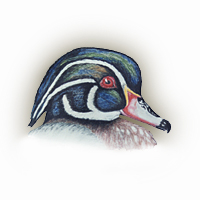|
Field
Guide IDs: BREEDING:
Wooded swamp,
bottomland slough, flooded forest, pond, marsh. 1
brood, occ 2, esp in s. DISPLAYS:
Courtship and pair
formation begin in autumn, continue into spring.
Courtship bouts in groups avg 11 birds, males
outnumbering females; always includes
vocalizations. See: Duck
Displays. NEST:
Prefer tree cavity.
Lined with wood chips, down. Occ use abandoned nest
hole of other species, rock fissure.
Perennial. EGGS:
Creamy white. 2.0"
(51 mm). DIET:
Seeds, acorns,
berries, grain; aquatic and terrestrial insects,
other invertebrates. CONSERVATION:
Winters s to Cuba
and Bahamas. Market-hunted for plumage, food, and
eggs; nest habitat lost through development and
forestry practices; by early 1900s verged on
extinction, but made comeback. Readily use nest
boxes. NOTES:
Older males pair
earlier in season than yearlings. Females show
extremely strong nest site tenacity. Clutches of
15-50 result from 2-10 + females contributing to
individual nests ("dumped"); dumping increases with
increased density of nest boxes. Female will repel
parasitizing females from her nest. Young remain in
nest 24 hours; sharp-clawed, can climb up to 8' out
of cavity. If disturbed, young submerge like grebe
or dive to reach cover. ESSAYS: REFERENCES:
Armbruster, 1982;
Bellrose, 1976; Drobney and Fredrickson, 1979;
Gooders and Boyer, 1986; Semel and Sherman,
1986. |
